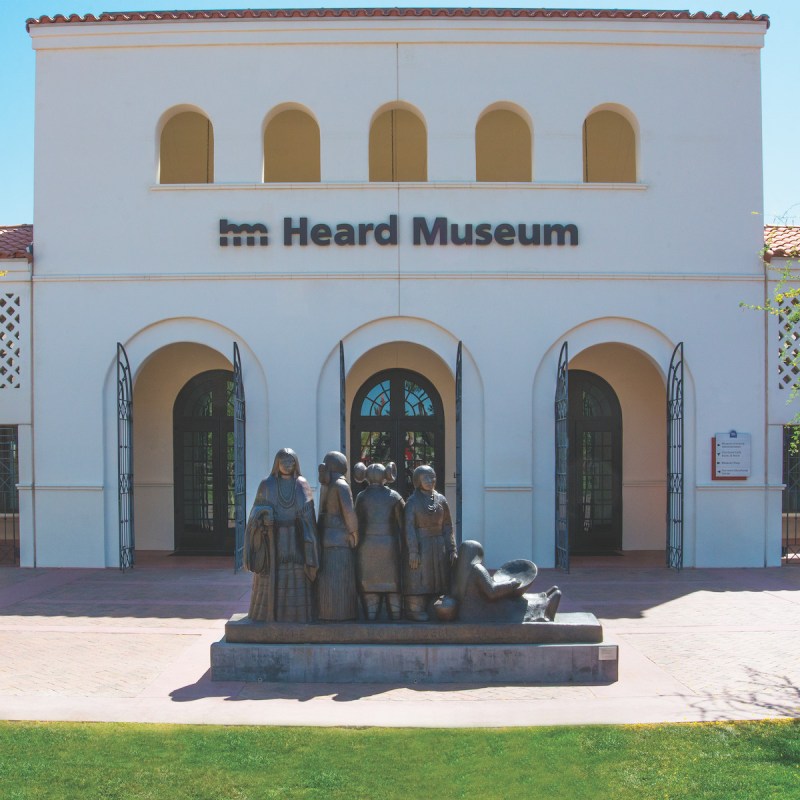
Famous for its gorgeous desert landscape and unbearable summer heat, Phoenix is one of the largest metropolitan areas in the United States. Home to a culturally diverse population, the city also attracts visitors from around the world who fly into Sky Harbor Airport on their way to the world-renowned Grand Canyon. This makes the Phoenix area the perfect place for world-class museums.
Videos by TravelAwaits
During the three decades I’ve lived here, I’ve seen some of these museums grow and others being built. Some highlight the area’s history, from ancient to modern times; others showcase local and international culture, art, and music. These museums have put Phoenix on the cultural scene of the country and the world.
Covering everything from native culture to archaeology, music, and art, here are a few unique museums in Phoenix.
1. Heard Museum
Dedicated to the Native Americans of the Southwest and other indigenous people around the world, the Heard Museum is unique in the country. Established in 1929, it is one of the oldest museums in Phoenix, recognized for the quality of its collections and exhibitions, educational programs, and festivals.
The museum’s extensive Hopi katsina doll collection that left me in awe three decades ago has since been expanded to be part of the exhibit called HOME. This is the first gallery you’ll visit upon entering the museum. Here, you’ll see artifacts that represent the concept of home for the indigenous nations of the Southwest, from ancient times to today. The exhibited objects include traditional homes, pottery, clothing, weaving, basketry, and cooking utensils. Highlights include a traditional Pueblo oven, the 400-piece Hopi katsina doll collection, and a full-size Navajo hogan.
From the HOME galleries, walk over to the inner courtyard to visit the Away from Home exhibit upstairs. The American Indian boarding schools stories address a sad moment in history when Native American children were forced to live away from home and give up their culture, language, and identity.
Leave this exhibit through the gallery showcasing the Around the World exhibit, which explores the culture of other native tribes of North America, the Pacific, and Latin America. Past it, a two-story gallery hosts temporary exhibits, leading back to the HOME exhibit. Before exploring the rest of the museum, step outside and enjoy the sculpture garden.
Four other galleries, including the Grand Gallery, host temporary or rotating exhibits showcasing the work of indigenous artists.
Pro Tips: Allow at least 2 hours to visit the museum for the best experience. Check for special exhibits or shows before you visit, since the Heard often hosts native cultural events.

2. Musical Instrument Museum
Unique in the world, the Musical Instrument Museum offers an immersive, interactive visitor experience, showcasing musical instruments from all over the planet. Alongside the instruments, you’ll find related artifacts and extensive information about their makers, players, and the cultures that use them.
I watched the museum being built in 2010, and though I visit it often, I still find it fascinating. Offering a global experience, the museum displays over 6,000 instruments and associated artifacts from 200 countries. Though it sounds overwhelming, the setup is user friendly thanks to the building’s architecture. Light and spacious, the main corridor linking the galleries evokes the forms and shapes of musical instruments and the geology of the Southwest. Without noticing, you become one with this music-filled landscape, enjoying every minute spent here.
Musical instruments surround you as soon as you step away from the main lobby. A pipe organ greets you on the wall across the stairway, while instruments from all over the world hang overhead. As you look to your right, you’ll notice an octobass, an extremely large and rare stringed instrument.
Upstairs, in the Geographical Galleries, you’ll travel the world through music, from Africa and the Middle East, Asia, and Oceania to the Americas and Europe. Surrounded by music every step of the way, you’ll appreciate not only the specific instruments used on each continent, but also the overall culture of these places.
Other galleries include the Artist Gallery, the Mechanical Music Gallery, and — the most fun of all — the Experience Galleries, where you can play the instruments on display.
Pro Tips: Allow at least 3 hours to visit the museum, although you could easily spend half a day there. Take a break between galleries by sitting in the garden or in the museum’s alcove upstairs.

3. Phoenix Art Museum
The Southwest’s leading museum dedicated to visual arts, the Phoenix Art Museum offers a world-class visitor experience. Featuring more than 20,000 objects, the museum’s collection takes you around the world — in space and time — with works that span continents and centuries. Your visit will take you from ancient to contemporary times, and from Asia through Europe to the Americas.
Besides the paintings, drawings, photography, and sculptures you’d expect from an art museum, you’ll find unique pieces here. From large, three-dimensional pieces to a collection of miniature Thorne rooms, and from historic fashion to some of the most innovative contemporary art installations, you’ll see everything here.
The museum’s fashion design collection, spanning close to five centuries, is unique in the world. The collection of Thorne rooms, featuring 20 of the original 30 miniature rooms commissioned by Narcissa Niblack Thorne, is one of only a few in the country. But perhaps some of the most unique pieces of the museum’s collection are the contemporary art installations.
A favorite of visitors of all ages is the mixed-media installation titled You Who Are Getting Obliterated in the Dancing Swarm of Fireflies, the work of Japanese artist Yayoi Kusama. More than a visual experience, this infinity mirror room plays with all your senses.
Besides the permanent collection, the museum hosts world-class temporary exhibitions, film programs, and live performances. It also takes part in the First Friday art events of Phoenix, offering voluntary-donation admission, live music and dance performances, art-making activities, and programs led by local artists.

4. Pueblo Grande Museum
Bringing the ancient history of Phoenix and the surrounding area into focus, the Pueblo Grande Museum showcases a 1,500-year-old archaeological site. Once inhabited by the Ancestral Sonoran Desert People (also known as the Hohokam), it is a place to learn about the ancient people who lived in this unforgiving desert environment long before air-conditioning.
Nicknamed the Canal Makers, they were some of the best engineers of the ancient world, finding creative ways to bring water into the dry Valley of the Sun. The museum’s newest trail, the Portal Loop Trail, focuses on this aspect of the ancient village, taking you on a walk near the Grand Canal. Though it has been modernized and expanded over the years, it is the same canal built by the Hohokam — still in use today, bringing water to the residents of Phoenix.
The original part of the outdoor trail showcases the remains of their ancient village, highlighting moments of its life. The outdoor garden grows the same crops using the same irrigation system of canals the Hohokam used. Stopping by it, you’ll learn about the “three sisters” — corn, beans, and squash, the staples of their diet.
You’ll find the ancient houses — replicas based on information from archaeological excavations — to be the highlights of the trail, though. Two pithouses, or dome-shaped houses dug down into the earth, stand alone. One is filled with artifacts, and the other is open to walk through. You’ll also see a newer home called a compound house. More rectangular, it comprises interconnecting rooms surrounding a courtyard.
The indoor exhibits, including dioramas and ancient artifacts, bring it all together, summarizing the history and way of life of the ancient people who built this village.
Note: Due to COVID restrictions, the indoor part of the museum is closed to the public. They are hoping to reopen later in the summer but have no definite date. In the meantime, you can enjoy the outdoor trails for free.
Pro Tip: When visiting any outdoor exhibits, carry water and wear a hat and sunscreen. For the best experience, visit during the winter or the shoulder seasons. If you go during the warmer months, visit in the early morning.
For more to do in Phoenix, see this page.
